If you have a garden, you are sure to see some bad garden bugs – insects, pests, bugs, flies, caterpillars, and wasps every day.
It’s important to know which bugs in the garden are harmful and which are beneficial insects.
In this article, we’ll share brief descriptions of 30 common “bad garden bugs” (including a couple often misunderstood) which you may encounter in your garden.
Read on to learn more about common garden pests identification and see our bad garden bugs pictures.
Aphids
Aphids, of the family Aphididae, are also known as plant lice, green flies or ant cows.
These tiny, soft-bodied, sap-sucking insects are members of the order, Homoptera.
They are very small, no larger than the head of a pin. Most members of this family have two cornicles (tiny tubes) located on the abdomen.
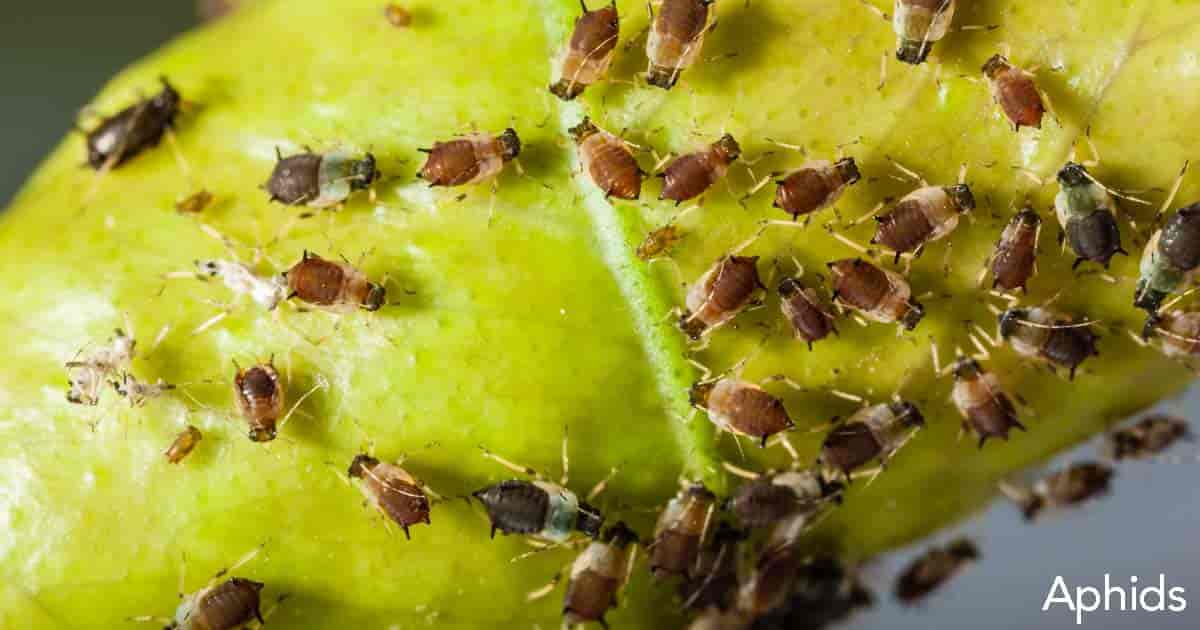
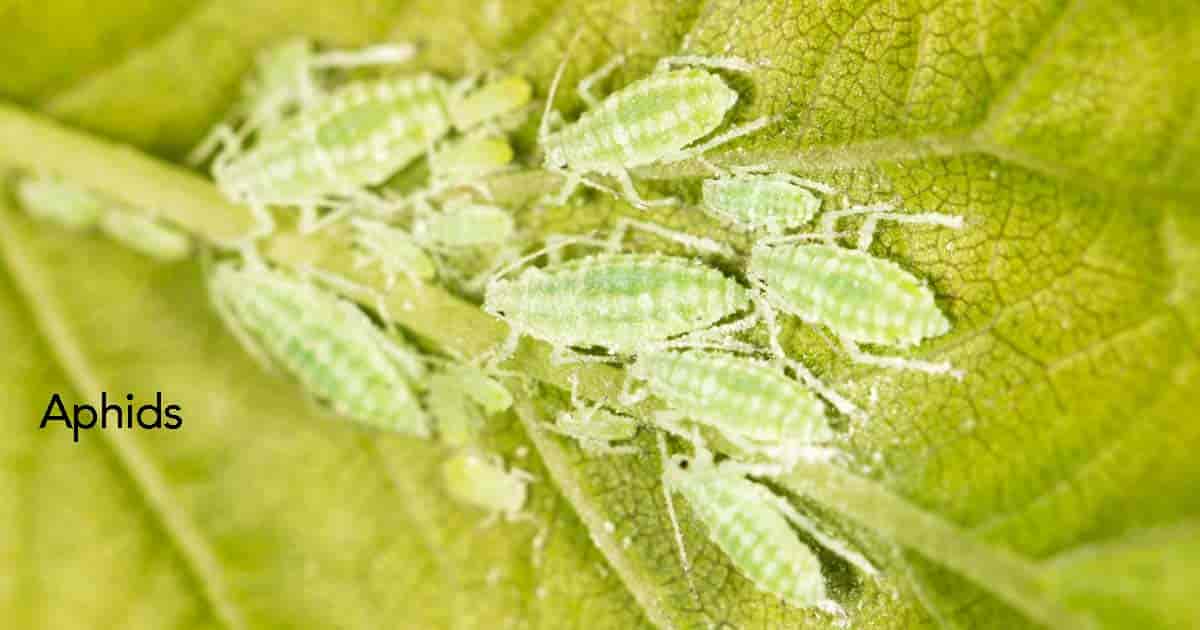 They use these to suck plant sap from tender young plants. Although aphids are very small black bugs on plants, they can be a big problem in the garden on vegetables and flowering plants.
They use these to suck plant sap from tender young plants. Although aphids are very small black bugs on plants, they can be a big problem in the garden on vegetables and flowering plants.
An aphid infestation can stunt your plants’ growth, cause the development of galls and deformation of buds, flowers, and leaves. Aside from that, aphids carry plant viruses.
NOTE: Lady Beetles are a natural option to get rid of aphids.
More On How To Get Rid Of Aphids Naturally
Armyworms
Armyworms are members of the Pseudaletia unipuncta family. They are the larvae of the owlet moth, which belongs to the Noctuidae family.
These caterpillars cause significant damage to grain crops because they tend to travel in large swarms gobbling up everything in their path.
 Armyworm known as the “Beet Armyworm”
Armyworm known as the “Beet Armyworm”
These herds of caterpillars can travel long distances on the ground in search of food and living space and are bad worms in garden soil.
A stampede of armyworms can destroy vast swathes of cotton, sugar cane, corn and other grains, just to name a few of their victims.
When it is time to pupate, they stop traveling and eating and settle down in one place to metamorphose.
The term “armyworm” is often applied to other types of caterpillars that gather to move about and feed.
More on How To Get Rid Of Garden Armyworm Pests
Black Vine Weevil
Black vine weevil is a member of the Otiorhynchus sulcatus family. It is also called the taxus weevil.
This pest eats many different types of ornamental garden plants. When it is in the larval stage, it is especially destructive to broad-leaved evergreens, such as rhododendron, hemlock, and yew.
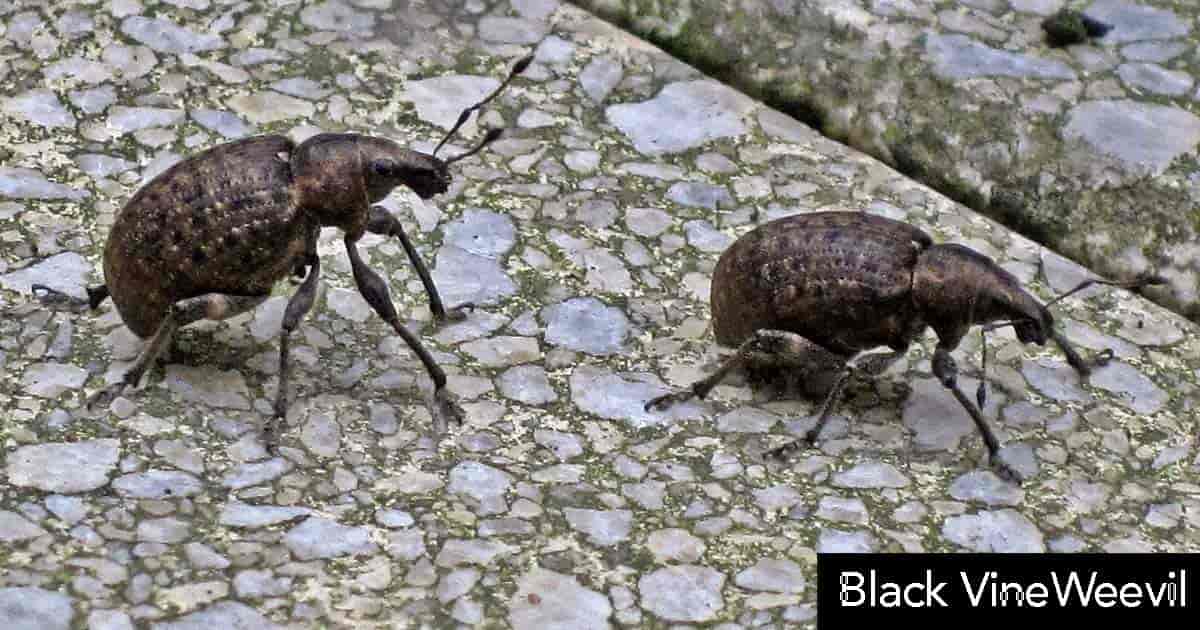 These weevils can also be bothersome in a greenhouse setting as they like to eat tender plants such as impatiens, cyclamen, and asters.
These weevils can also be bothersome in a greenhouse setting as they like to eat tender plants such as impatiens, cyclamen, and asters.
Adult weevils are not picky. They eat a wide variety of herbaceous and deciduous plants.
Because of their broad range and voracious appetite, these root weevils are among the most devastating garden pests in North America.
More on Controlling The Black Vine Weevil Beetle
Blister Beetle
Blister beetle is a member of the Meloidae family and the insect order, Coleoptera.
There are more than 2500 species of this type of beetle.
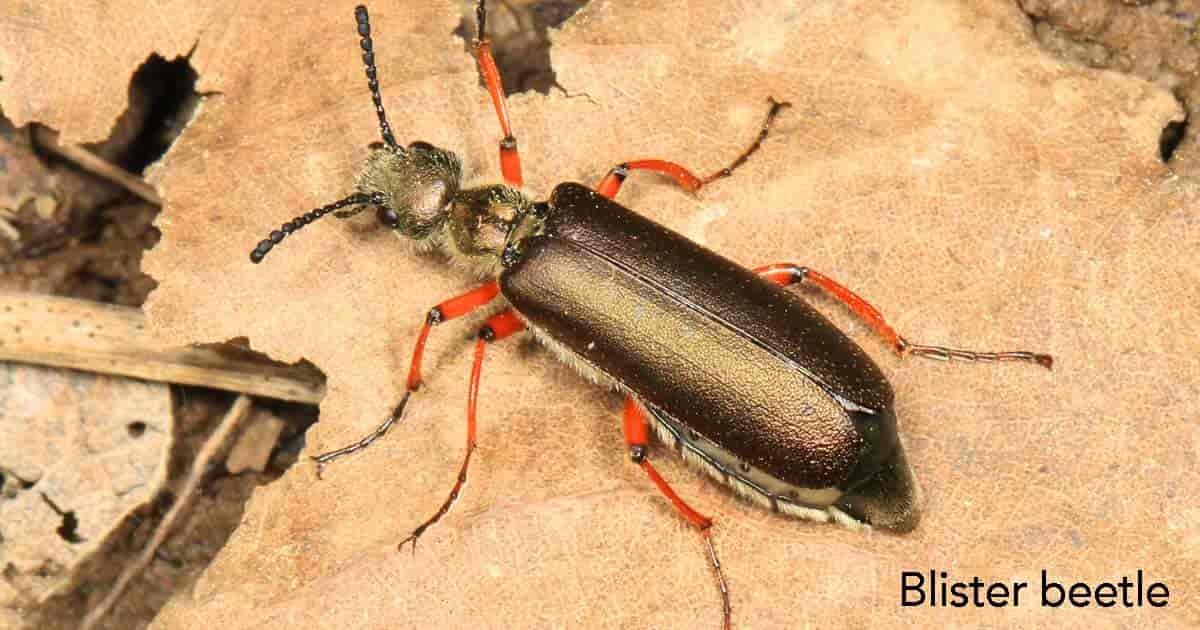 Blister Beetle image via Flickr
Blister Beetle image via Flickr
They are all aptly called blister beetles because they secrete an irritant called cantharidin that causes itching, burning and blistering of the skin on contact.
It is mostly sourced from European members of the species. As garden pests go, blister beetles are both friend and foe.
The larvae help keep your grasshopper population under control by eating their eggs.
The adult red and black bugs in garden will eat up your crops.
More on How To Control Blister Beetles [In The Garden]
Boxelder Bugs
Boxelder bugs are “true bugs” members of the Order: Hemiptera. They earned their name from living on the Boxelder tree.
These bugs find themselves confused with other “family members” like stink bugs, squash bugs, red-shouldered bugs, bordered plant bugs, and cicadas.
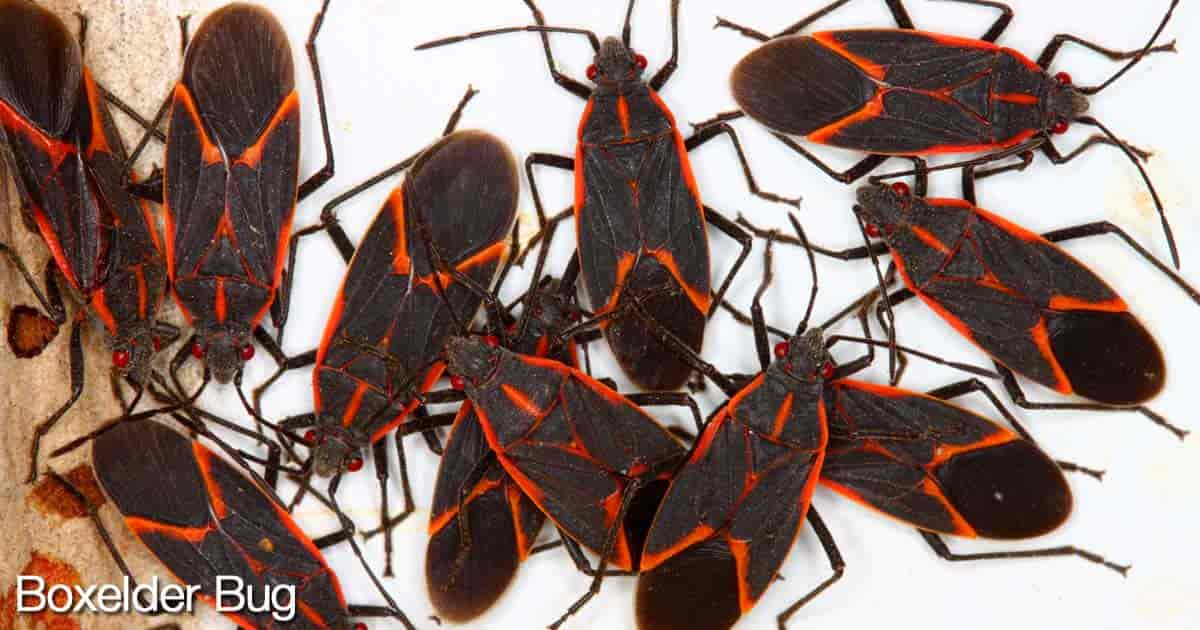 Box elder bugs have red veins sitting on top of charcoal-colored wings.
Box elder bugs have red veins sitting on top of charcoal-colored wings.
They tend to invade outbuildings, homes, and trunks of trees in the fall to hibernate when cool weather rolls in. When spring arrives they emerge and become something of a nuisance pest.
Learn more about Boxelder Bugs with 13 Facts, Information and Pest Control
Cabbage Looper
Cabbage looper belongs to the Trichoplusia ni family. This caterpillar is a handsome devil with its bright green color and sporty white stripes.
Cabbage loopers are related to armyworms, and as adults, they become members of the owlet moth family.
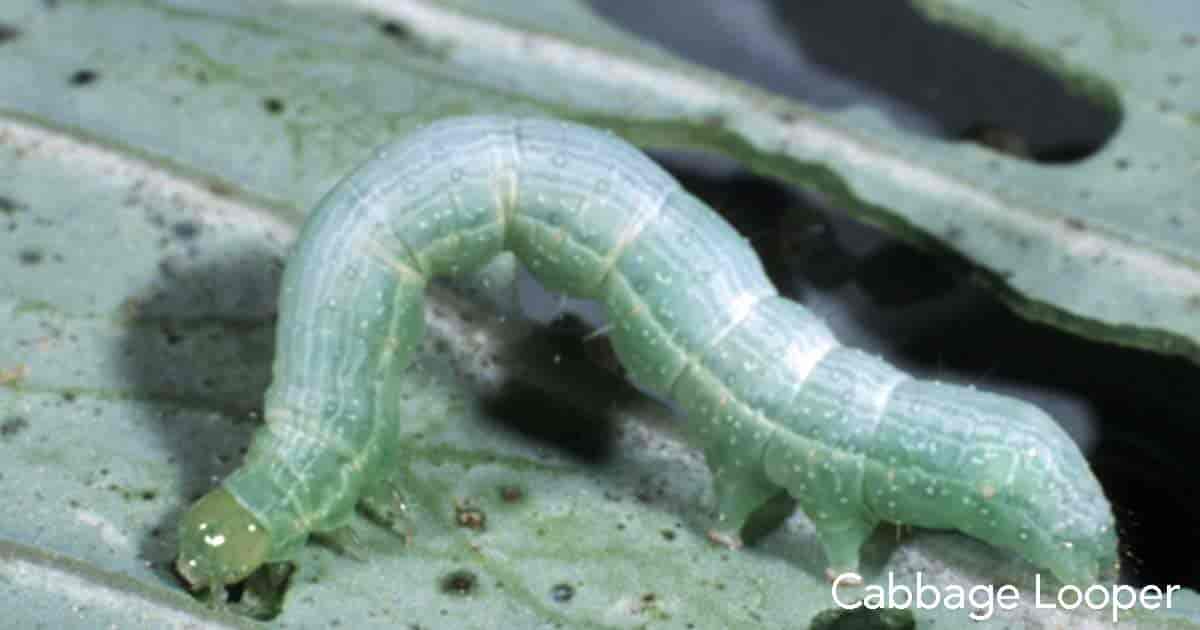 Image Via Flickr – CC 3.0
Image Via Flickr – CC 3.0
Adult cabbage loopers are known as Ni moths, and they can fly long distances looking for food and breeding grounds.
These large (1″) moths are rather nondescript with mottled brown wings and Y-shaped markings on the forewings.
Cabbage loopers are easy to recognize because of their distinctive coloration and markings and the fact that they have three sets of front legs.
Most caterpillars have 4 sets of front legs. Because of this leg shortage, cabbage loopers have a distinctive, looping gait, which accounts for their name.
NOTE: Bacillus thuringiensis is a natural method to control caterpillars.
More on Cabbage Looper Caterpillar Worms – [15 Tips] To Identify, Kill and Get Rid Of Them
Colorado Potato Beetle
Colorado potato beetle belongs to the Leptinotarsa decemlineata family. These beetles are also commonly called potato bugs.
These voracious little insects make short work of potato plant leaves.
 Colorado potato bugs are native to the North American west. They originated in the Rocky Mountains where they ate a wild member of the potato family known as buffalo bur.
Colorado potato bugs are native to the North American west. They originated in the Rocky Mountains where they ate a wild member of the potato family known as buffalo bur.
When cultivated potatoes were brought west by the pioneers, potato bugs had no trouble adjusting and enjoying the feast and have followed potato crops wherever they might lead ever since.
Today, these jaunty round beetles are commonly found on potato plants in all parts of North America.
The dime-sized beetles are easy to recognize with their bold black and gold (or small yellowbug) stripes. Their bodies are reddish orange.
They reproduce rapidly by laying as many as 500 eggs to a clutch on the undersides of the leaves of potato plants.
They can lay eggs as many as three times annually. The larvae drop to the ground and live among fallen leaves, eating the leaf litter.
You usually don’t see the larvae or pupa. You will only notice them when they emerge as adults to eat your potato plants.
More on The Colorado Potato Bug – What They Look Like and Getting Rid of Them
Striped Cucumber Beetle
Striped cucumber beetles belong to the Acalymma vittata family. These bugs have double black stripes on the wing covers. You know the “black bug with yellow stripes on back.”
The spotted cucumber beetle is a similar bug, but it has black spots instead of stripes.
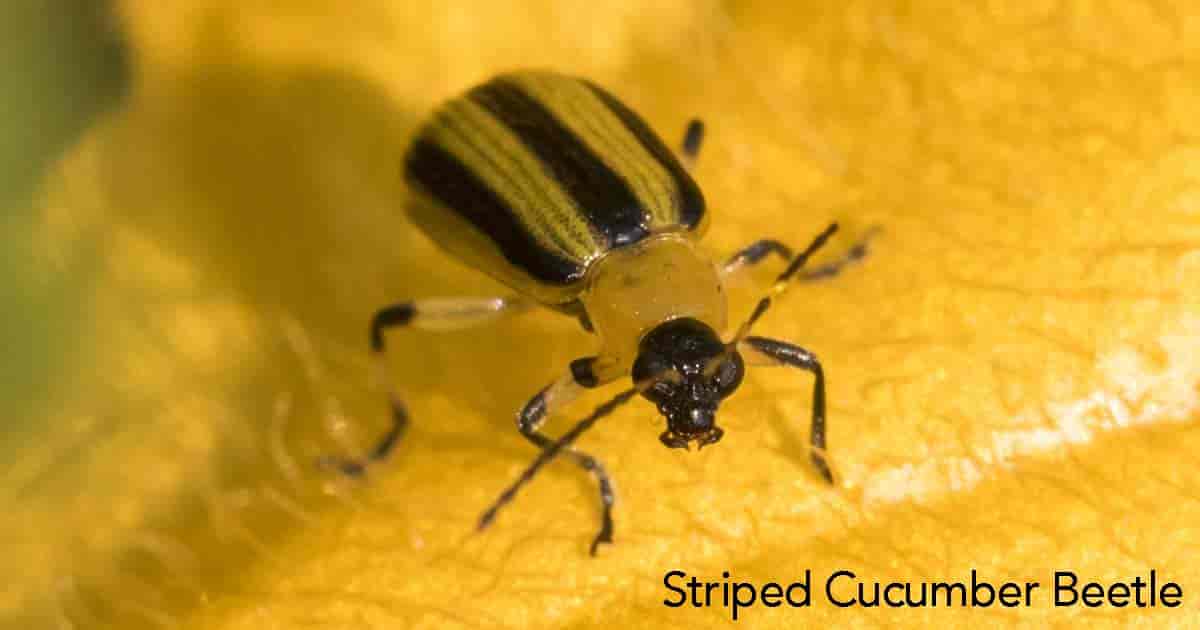 Both of them eat plant roots as larvae and garden plants as adults.
Both of them eat plant roots as larvae and garden plants as adults.
There is also a variety that exclusively eats the pollen and silk of corn. Their larvae feed on corn roots and are called corn rootworms.
More On Cucumber Beetle Control – Getting Rid Of Striped, Spotted Cucumber Beetles [HOW TO]
Cutworms
Cutworms are another relative of true armyworms and become a type of owlet moth as adults.
These caterpillars pose a great deal of harm to a variety of crops, most especially tobacco.
 There are some sorts of cutworms that attack garden crops such as beans, tomatoes, and corn overnight.
There are some sorts of cutworms that attack garden crops such as beans, tomatoes, and corn overnight.
They sever the roots and the stems at ground level.
They may also wreak havoc with grasses and can cause severe damage to lawns.
There are some types of cutworms that live exclusively underground and eat only plant roots. Consider cutworm collars when transplanting to control.
More On Cutworm Control: How To Treat Cutworms In The Vegetable Garden
Flea Beetle
The term “flea beetle” refers to several different bad bugs who are all members of the insect sub-family known as Alticinae (Halticinae).
This sub-family is a part of the larger leaf beetle family, Chrysomelidae, which is a part of the Coleoptera order.
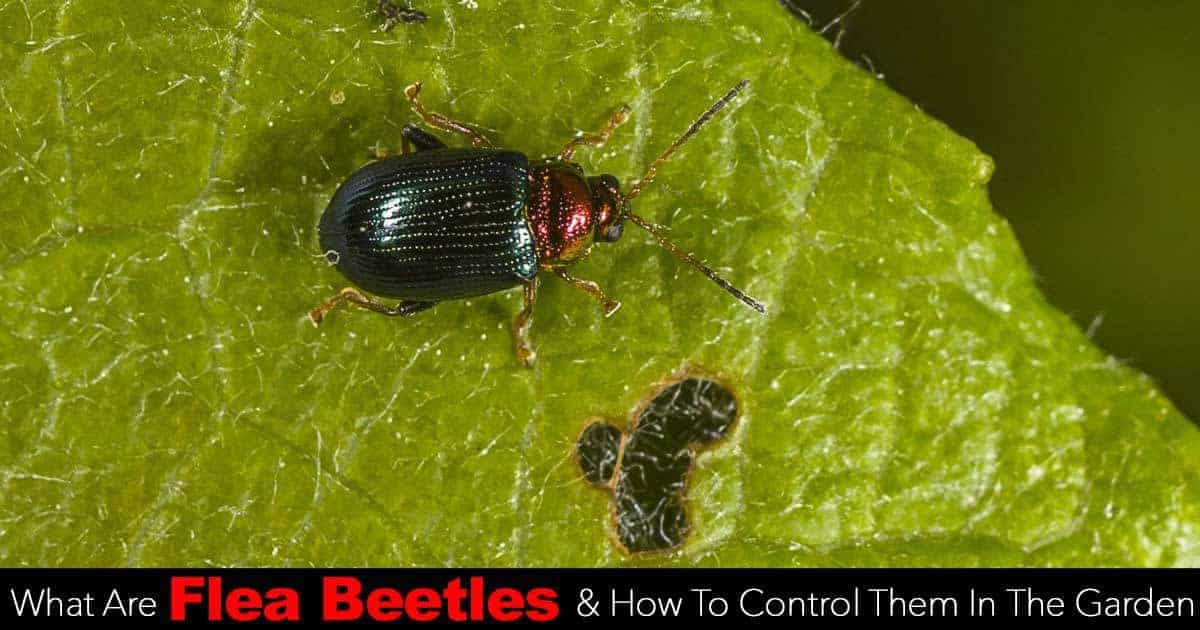 At less than a quarter of an inch long, flea beetles are quite tiny.
At less than a quarter of an inch long, flea beetles are quite tiny.
They are metallic or dark colored, and they have very strong hind legs that allow them to jump long distances (hence their nickname).
One variety or another of this little black bug on plants can be found in all parts of the world.
They are major pests as the adults make short work of leaf crops, and the larvae decimate roots in nothing flat.
These creatures also cause damage to plants by spreading disease, such as early potato blight.
More on Flea Beetles and Controlling Them In The Garden
Japanese Beetles
The Japanese beetle or Popillia japonica immigrated to the United States early in the 20th century.
Their mode of transport to the US is uncertain, but it is probable that the Japanese beetles larvae cast away in the soil surrounding potted plants imported from Japan.
 These voracious beetles feed on a vast number of plants and can decimate many nursery plants, many types of grasses and a wide variety of shrubbery and trees in a very short time.
These voracious beetles feed on a vast number of plants and can decimate many nursery plants, many types of grasses and a wide variety of shrubbery and trees in a very short time.
They travel and feed in large swarms, and have been known to strip everything edible off a peach tree in a quarter of an hour, leaving the tree completely bare with pits protruding where fruit once hung.
Note: The June bug eats, feeds and does damage much like the Japanese beetle. Use the same control measures.
More on Japanese Beetle Control
Lace Bugs
Lace bugs come in many species. In fact, there are about 800 different types of lace bugs in the Tingidae insect family.
All belong to the Heteroptera order. Adult lace bugs of all sorts are usually about 2/10th of an inch in length.
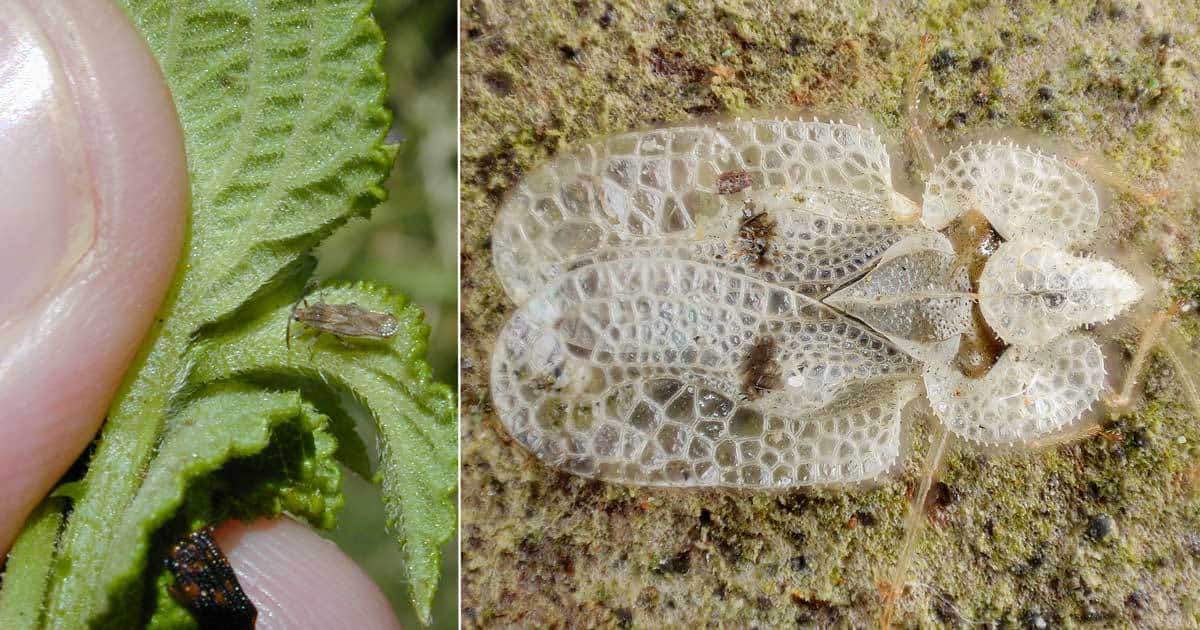 They get their name from the lacy membrane that covers their wings and the upper portion of the body.
They get their name from the lacy membrane that covers their wings and the upper portion of the body.
Lace bugs are sap-suckers that draw the juices from leaves. When they prey on a plant, the foliage develops yellow spots, turns brown and falls.
More on Getting Rid Of Lace Bugs
Leafhoppers
Leafhoppers are also sap-sucking insects. They are members of the Cicadellidae or Jassidae family in the Homoptera order.
These prettily colored bugs are not especially worrisome in small numbers, but when they congregate they can do a lot of damage.
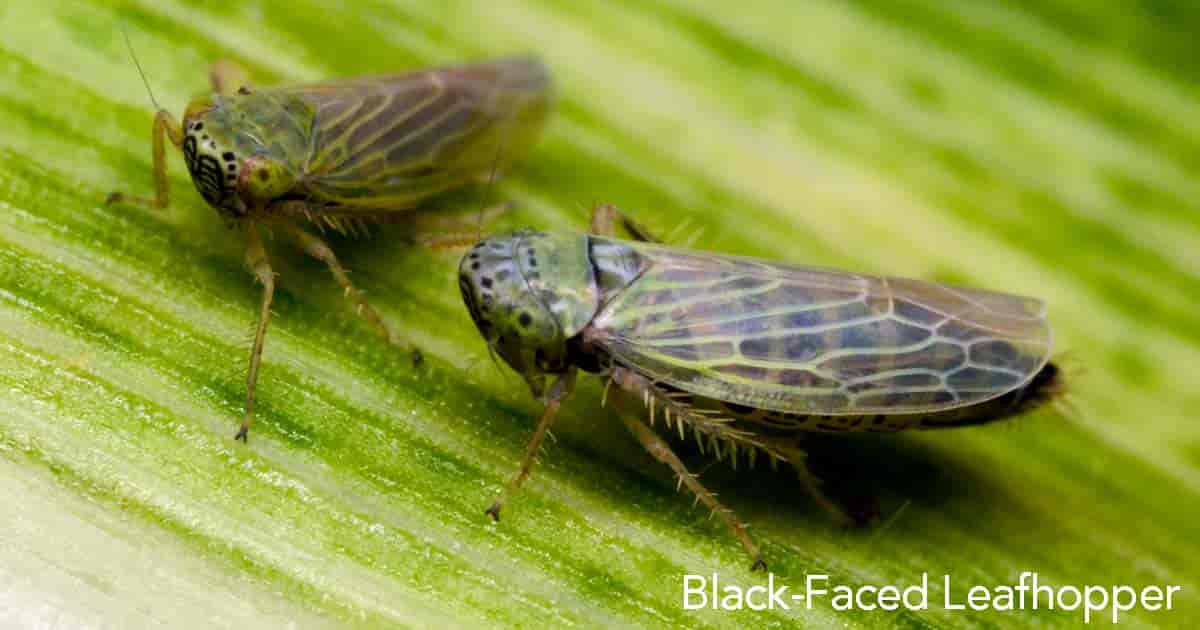 See page for author [Public domain], via Wikimedia Commons
See page for author [Public domain], via Wikimedia Commons
They injure plants in a wide variety of ways because they can transmit diseases, destroy the plant’s life-giving chlorophyll and suck out all the sap from stems and leaves.
These damages are just caused by feeding.
When leafhoppers lay eggs, they punch holes in plants leaving scars and eggs that will hatch out into damaging larvae.
When you see that your plant has curling leaves, leafhoppers may be the culprits.
More on Controlling Leafhopper Insects – a Diverse And Abundant Group Of Garden Pests
Leaf Miner
Leaf miner is a term that is applied to several different types of pests that live and eat inside leaves.
They come from several different orders of insects and include caterpillars and a wide variety of insect larvae and fly maggots.
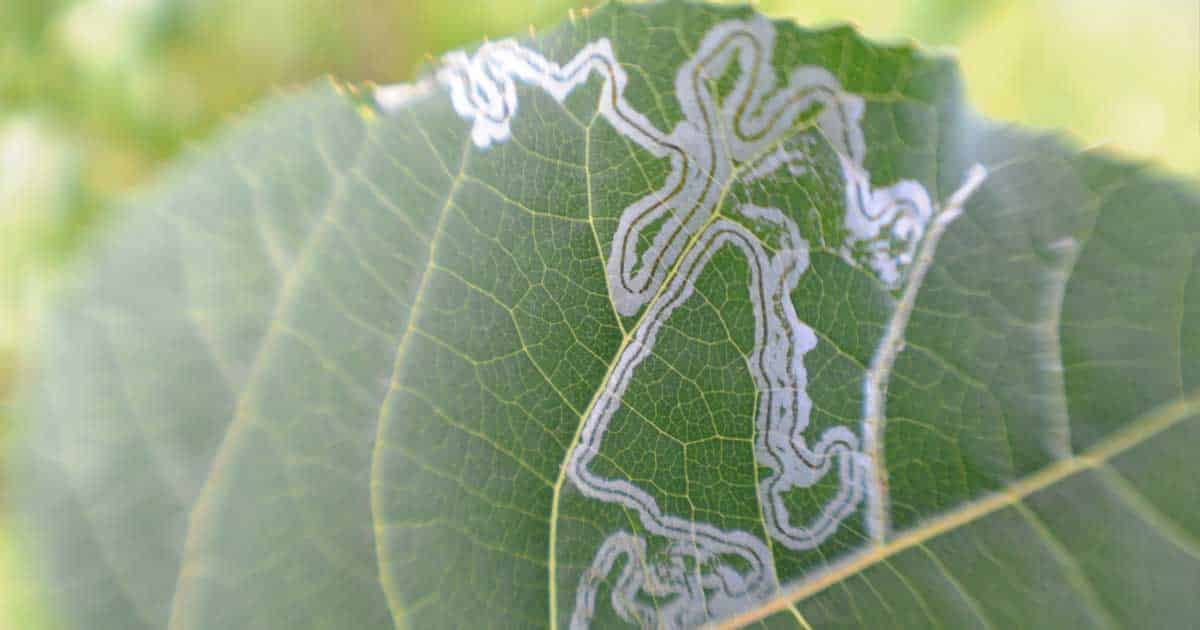 If you see winding white lines or trails on leaves, suspect some sort of leaf miner. The trails may be narrow or wide.
If you see winding white lines or trails on leaves, suspect some sort of leaf miner. The trails may be narrow or wide.
They may be any shade ranging from nearly white to brown.
Some leaf miners burrow into leaves and cause “blotch mines”, which appear as blighted spots rather than lines.
The presence of leaf miners is not really much of a threat to plants, but it does cause unsightly damage.
The best way to deal with them is to cut off infested branches and burn them.
Insecticides are ineffective against these pests because they are protected inside the leaves.
More on How To Control Leaf Miners
Mealybugs
The term, mealybug refers to several different members of the Pleudococcidae family.
These are very small sap-sucking insects that can be found in all locations around the world.
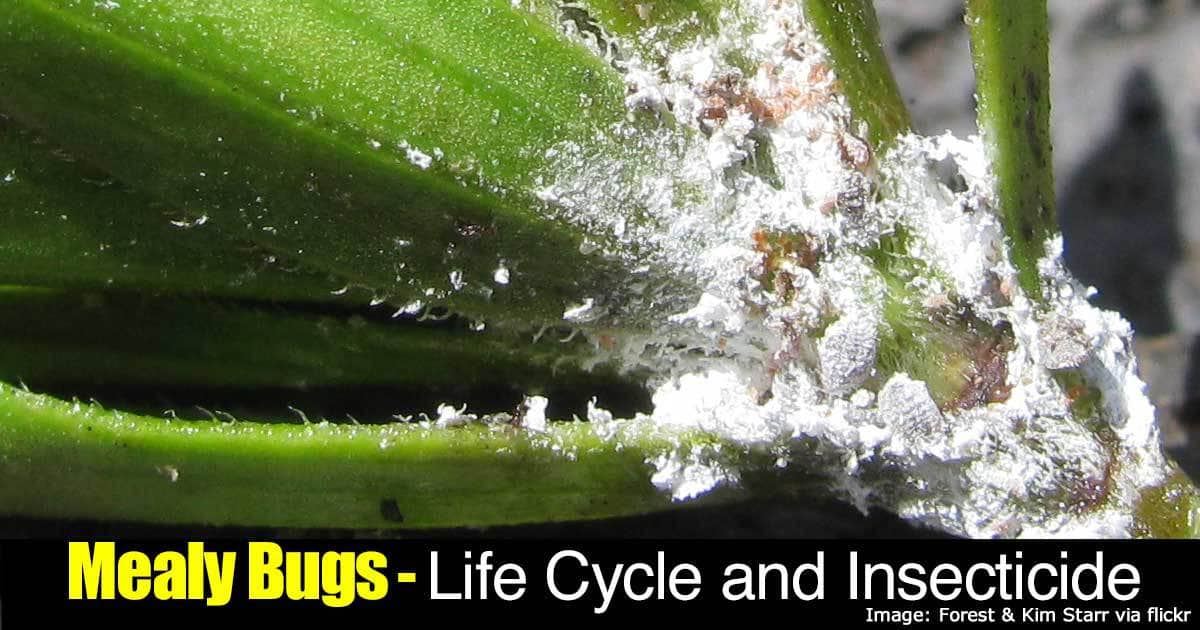 They are especially pesky to indoor plants, greenhouse plants, outdoor ornamentals and citrus trees.
They are especially pesky to indoor plants, greenhouse plants, outdoor ornamentals and citrus trees.
They are called mealybugs because their bodies are covered with a sticky white powder that looks like cornmeal.
If these bugs are present, you will see females and active young (i.e. crawlers) clustered on plant veins and the underside of the leaves.
The males are winged, and you will see them flitting from place-to-place.
The various types of these bugs can be controlled through the use of insecticides, horticultural oils, insecticidal soap or natural predators, such as ladybugs.
More on How To Get Rid Of Mealybugs
Mites, Spider
Spider mites use their two needle-like stylets to puncture the leaf undersides where they begin to suck out water and green chlorophyll plants need to produce food.
Leaves have a speckled or stippled appearance where mites are feeding.
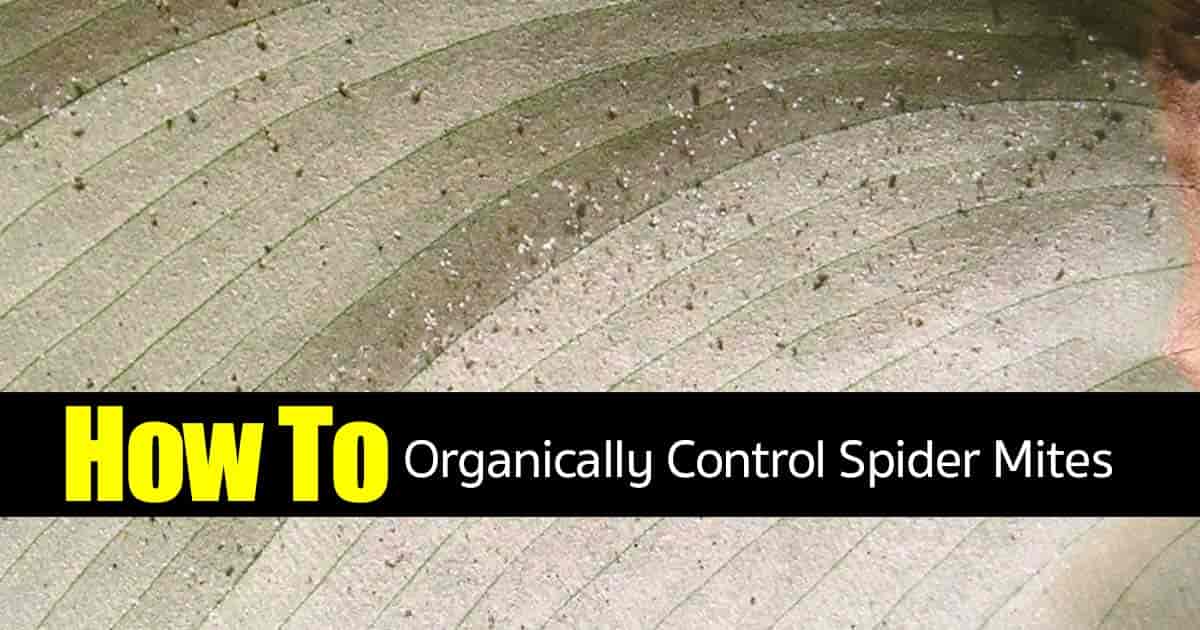 Plants lose vigor, leaves begin to shrivel and plants overall display a lack luster appreance.
Plants lose vigor, leaves begin to shrivel and plants overall display a lack luster appreance.
Commonly found on indoors plants, but also garden aand landscaping plants. Some mites species limit their attack to particular plant species.
More on Controlling Spider Mites Indoors and In the Garden
Pill Bugs
Pill bugs and sow bugs look very much alike, and interestingly they are not insects.
They are actually land-dwelling crustaceans and are closer kin to crawdads and shrimp than to any sort of insect.
Although these little bugs are the only crustaceans that live entirely on the land, they do need to be in a damp environment.
 You will find them outdoors under rocks and leaf litter and indoors in damp areas.
You will find them outdoors under rocks and leaf litter and indoors in damp areas.
They are really not much of a pest because they don’t transmit disease, eat plants, bite or sting, but they can overpopulate and become something of a nuisance.
Sweeping them up and relocating them to another damp place is preferable to killing them.
These little bugs may be a quarter to a half inch long. They are usually gray or black, and they have segmented bodies.
Sowbugs and pill bugs differ slightly in that pill bugs can roll up into a ball when threatened and are sometimes called roly-poly bugs.
Sow bugs are not able to do this. These little bugs have seven sets of legs and two sets of antennae, but you can only see one set with the naked eye.
Sowbugs also have a pair of tail-like projections at the rear, but pill bugs do not.
Pill bugs and sow bugs typically scavenge on leaf litter and other decaying organic substances.
They may occasionally eat a tender plant shoot, but overall they do very little damage. [source]
More on Pill Bugs – Are Roly Poly Bugs A Problem In The Garden?
Rose Chafer
Rose chafer, also known as Macrodactylus subspinosus is found in areas with sandy soil and lots of vegetation. It is equally at home in orchards, ornamental trees, shrubbery and flower beds.
Adults of the species can grow up to half an inch long. These flying beetles are sometimes mistaken for wasps.
They are slender with short antennae and may be either tan or light green. Their very spiny legs may be orange or rust colored.
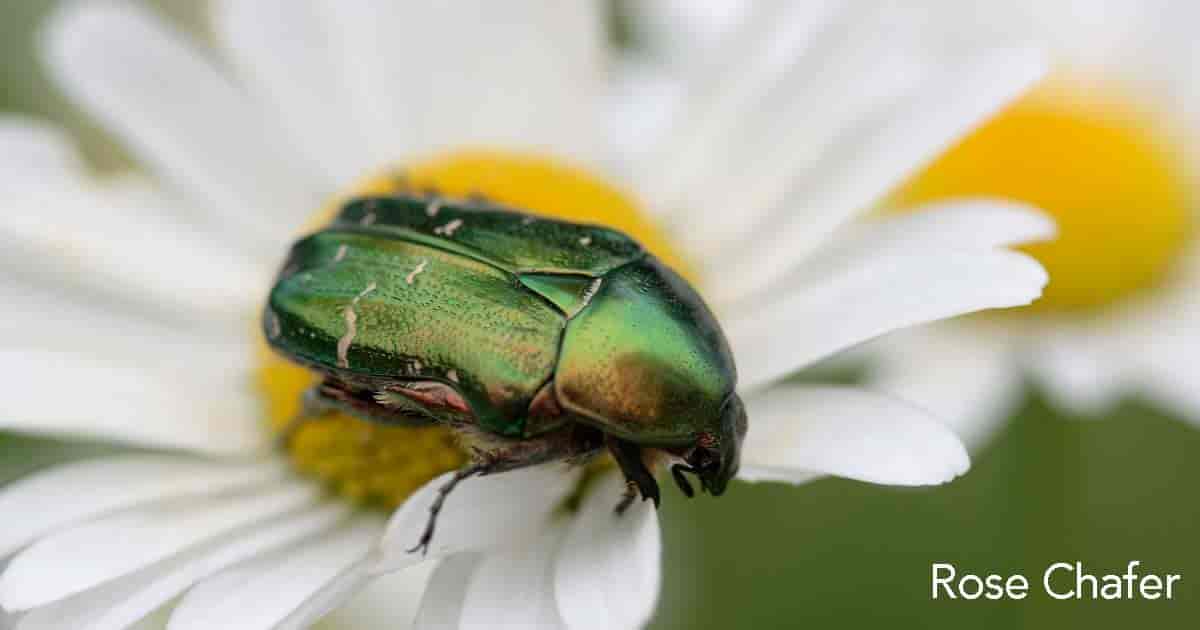 Adult rose chafers damage vegetation during the middle of summer.
Adult rose chafers damage vegetation during the middle of summer.
It is typical for them to consume a wide variety of plants throughout the month of June. Late in the summer, the female lays eggs in the sand and dies.
When the eggs hatch (late in the summer or early in the fall) larvae or grubs emerge.
These grubs grow to be about three-quarters of an inch long.
They are white with a brown head and prominent legs and the typical “C-shaped” grub body.
Like other types of grubs, they feed on grass and weed roots until early winter.
During winter, they burrow down below the frost line and wait for spring. In the springtime they pupate and emerge from the soil as adult beetles. [source]
Learn More with Tips For Controlling Hungry Rose Chafer Beetles
Soft Scale Insects
Soft scale insects are fairly large sap-sucking bugs (¼” inch long) that feed on the plant juices from a host plant’s vascular system, quickly draining away its life.
They tend to do the most damage during drought.
There are several varieties. Some hide by camouflaging themselves, chameleon-like.
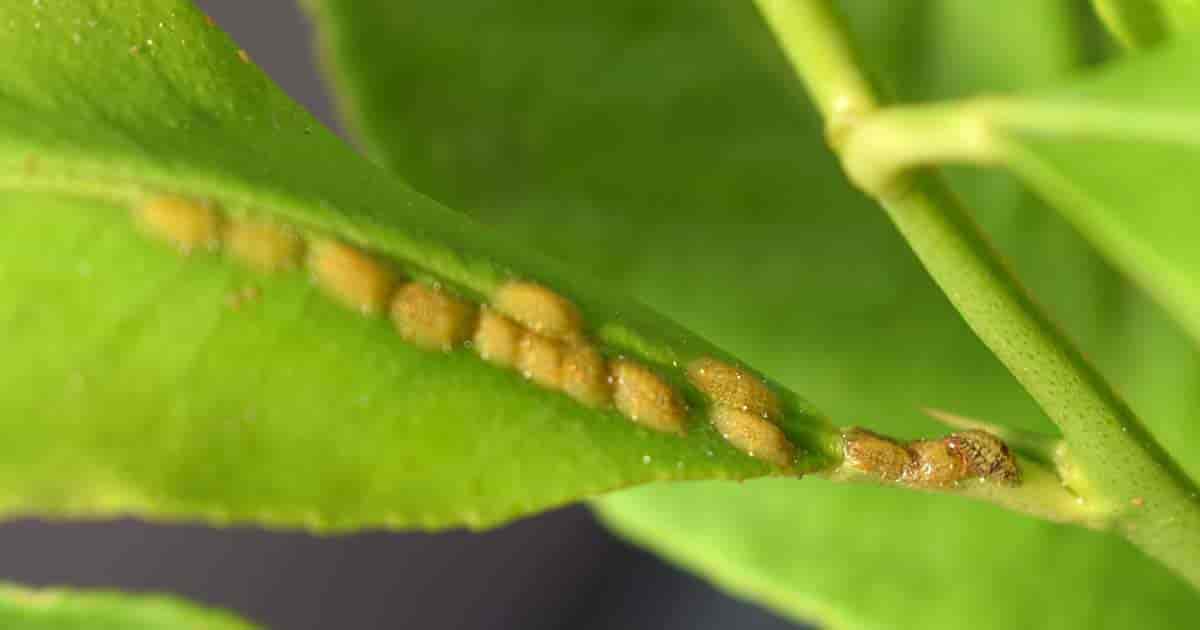 Others produce waxy, fluffy coatings to conceal themselves. These bugs come in a variety of sizes and colors, but all cause the same sorts of problems.
Others produce waxy, fluffy coatings to conceal themselves. These bugs come in a variety of sizes and colors, but all cause the same sorts of problems.
When you find your plant leaves coated with sweet, sticky honeydew, it’s a sure sign you have a soft-scale insect invasion.
It’s important that you clean up the sticky mess and sooty mold along with eliminating the garden pest for the health of your entire garden.
More on Plant Scale Bugs on Plants
Slugs and Snails
Slugs and Snails are not insects. They are gastropods and members of the mollusk family.
They have a single, ventral foot by which they propel themselves along and also digest their food.
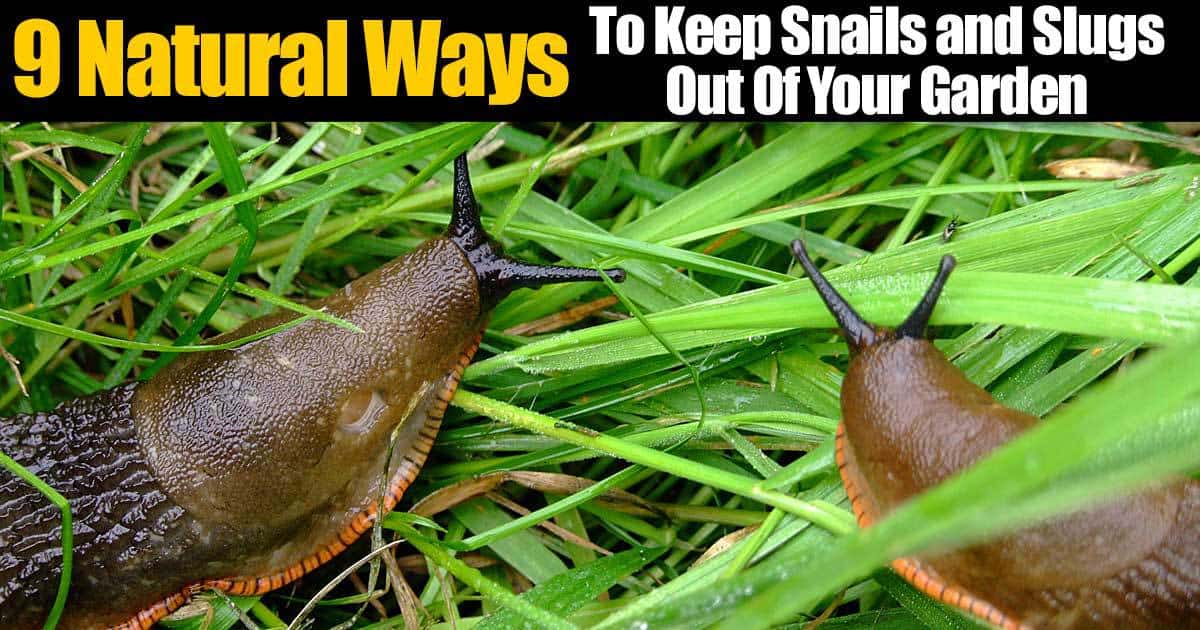 They like to live in shady, moist areas of the garden and enjoy eating tender young plants and seedlings, bulb shoots and some fallen fruit.
They like to live in shady, moist areas of the garden and enjoy eating tender young plants and seedlings, bulb shoots and some fallen fruit.
They are very fond of hostas and other plants and ground covers that grow in shady places.
If you have a slug or snail problem, you will notice holes in your plants and fruits.
If you have a problem with slugs and/or snails, you’ll find them actively feeding at night. Details on snail eggs and what to look for.
During the day, you can find them in cool, moist places under rocks, woodpiles, leaves, etc. [source]
More on How To Get Rid Of Garden Snails and Slugs
Spittlebugs
Adult spittlebugs are sometimes called Hoppers, Planthoppers or Frog Hoppers.
They look like very large, healthy and somewhat gaudy leafhoppers.
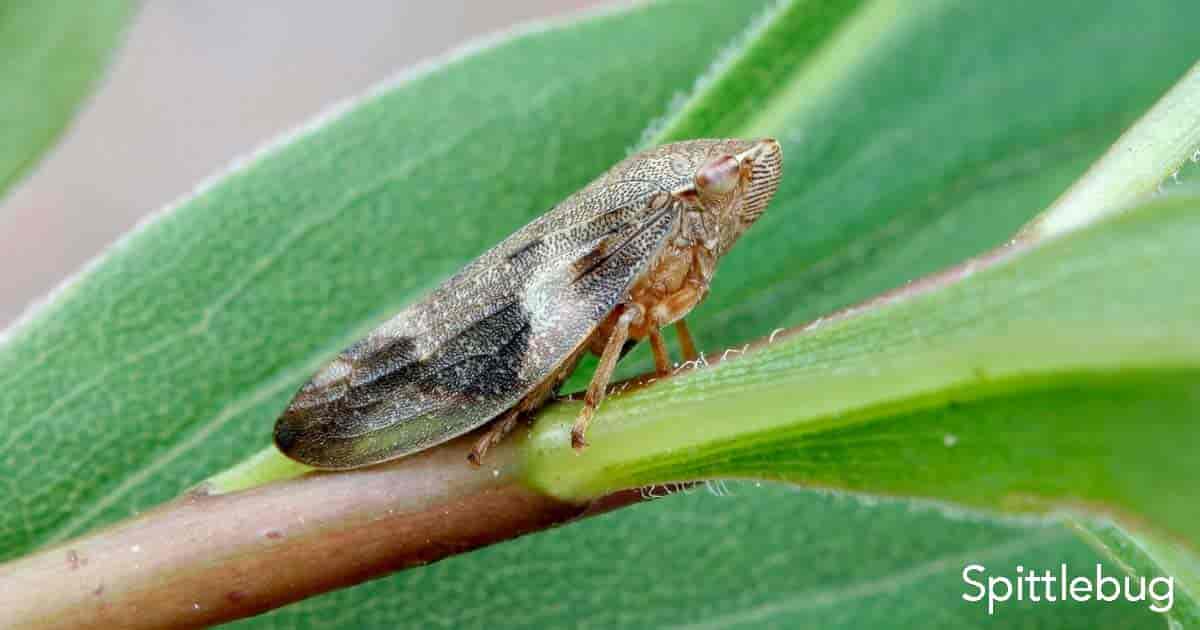 These pests sport a flashy, multicolored patterning. Adult females lay eggs between the stems and sheaths of plants, very near to the ground.
These pests sport a flashy, multicolored patterning. Adult females lay eggs between the stems and sheaths of plants, very near to the ground.
These hatch into tiny yellow nymphs which turn green as they grow older.
These nymphs create “spittle” by excreting a sticky substance from the alimentary canal and mixing it with air.
If you see gobs of a spittle-like substance on your plants, you’ll know that spittlebugs are present.
Both as adults and as nymphs, these pests cause garden damage by sucking the juices from plants.
This can cause stunted plant growth and overall loss of health.
This is a particular problem for legume crops, strawberries and nursery stock.
For this reason, it’s a good idea inspect your plant regularly and remove adults and nymphs by hand and drop them into a bucket of soapy water.
Alternately, try hitting them with a strong water spray. [source]
Learn How To Get Rid Of Spittlebug [FROGHOPPERS]
Squash Vine Borer
Melittia cucurbitae or squash vine borer comes from Missouri.
This pest causes serious damage to both winter squash and summer squash.
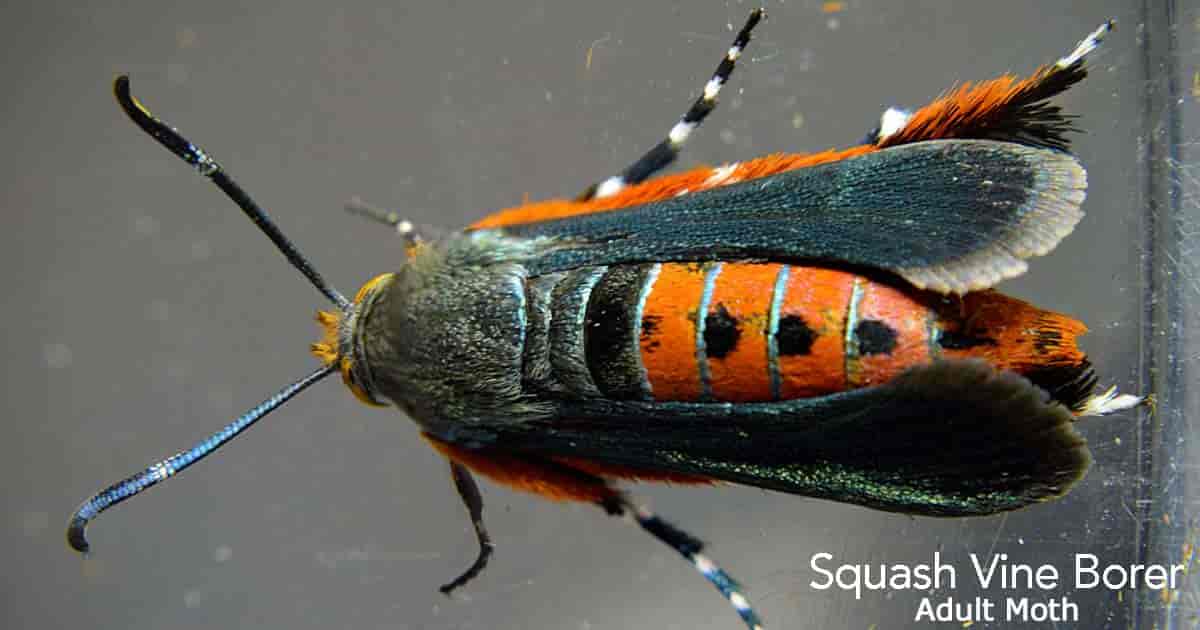 Melittia Cucurbite: Squash Vine Borer – Moth – image via: Insects Unlocked | James Marchment
Melittia Cucurbite: Squash Vine Borer – Moth – image via: Insects Unlocked | James Marchment
It also attacks pumpkins and cucumbers, as well as watermelons and muskmelons.
If you see that part of your vining squash or melon plant is wilting, suspect squash vine borers.
Examine the plant carefully. If you see something that looks like moist sawdust (i.e. “frass”) at the base of the plant, your suspicions will be confirmed.
The borers eject frass from holes they bore in plant stems. A lengthwise split in the stem is another dead giveaway.
If you see this, examine it closely. You are likely to find plump, white, brown-headed caterpillars in the split. These are your culprits.
More on Controlling The Squash Vine Borer
Stink Bug
It’s easy to identify a stink bug. Not only do they have a distinctive, almond-like odor, they are also unusual and interesting looking.
These bugs may be between a quarter-inch and a full inch in length. they are generally half as wide as they are long.
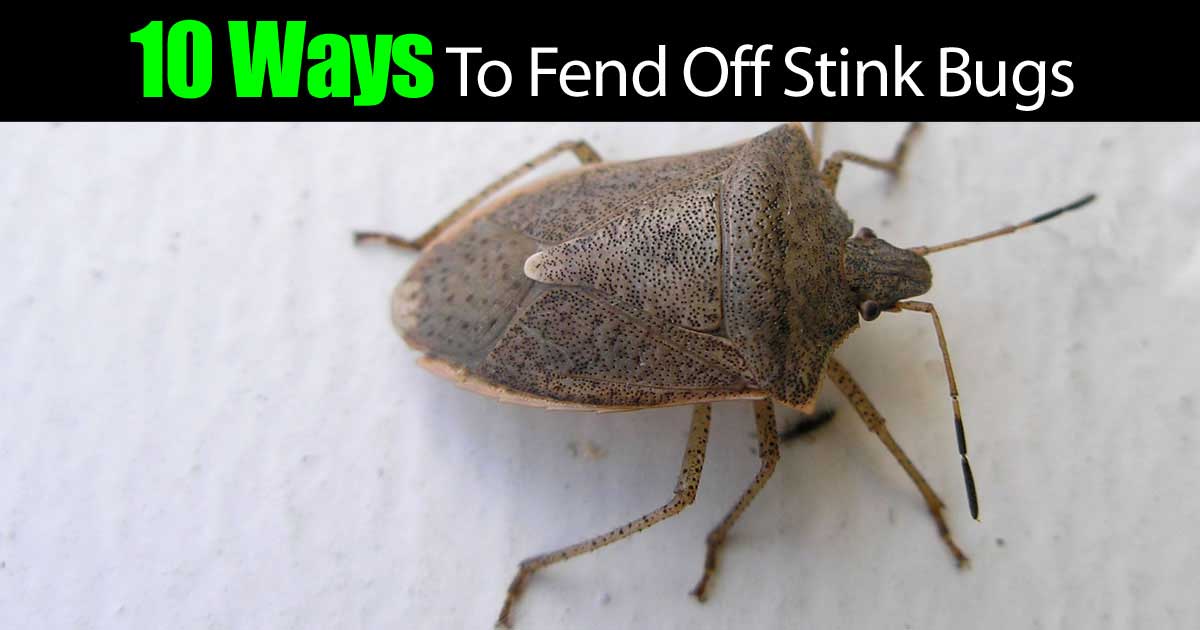 Stink bugs (aka: shield bugs) are in the assassin bug family, so they have a shield-shaped back with a triangular, horny scale.
Stink bugs (aka: shield bugs) are in the assassin bug family, so they have a shield-shaped back with a triangular, horny scale.
Even though stink bugs are related to assassin bugs, most are not beneficial. There are some exceptions, though.
Just remember that beneficial, predatory stink bugs have pointy projections on their shoulders (e.g. the two-spined soldier bug).
If you see this, your stink bug is friend and not foe!
Plant eating stiink bugs are usually yellow, green, gray or brown, but occasionally a fancy one with yellow or red markings will turn up.
You are likely to find stink bugs on a wide variety of host plants, including:
- Snapdragons
- Sunflowers
- Columbine
- Blackberry
- Soybean
- Eggplant
- Cabbage
- Tomato
- Corn
- Bean
They also favor fruit trees, such as cherry, pecan, peach and apple.
Stink bugs are “true bugs”, and they eat by poking their pointy mouth parts into fruit, buds, flowers and leaves and sucking up the sap of host plants. [source]
More on How To Get Rid of Stink Bugs
Harlequin Bug
Murgantia histrionica (aka: the harlequin bug) is a very flashy member of the stink bug family.
These bugs are red and black spotted and make short work of plants in the mustard family.
They do a great deal of crop damage in the southern areas of the United States.
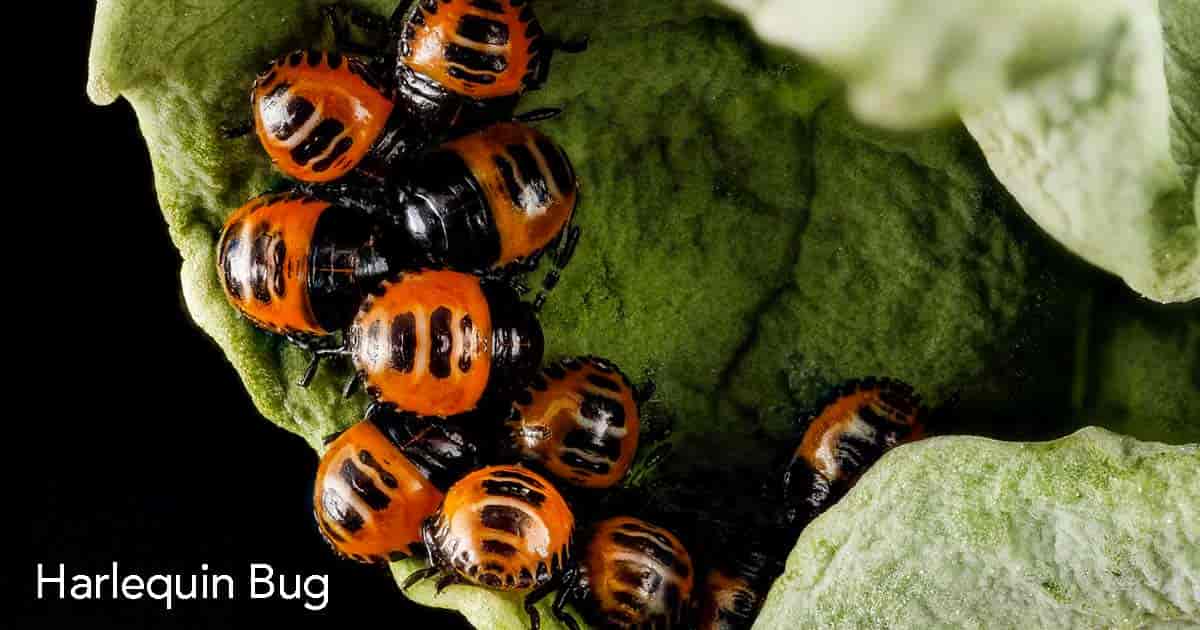 Harlequin Bug Murgantia histrionica, a common pest of brassicas, raised by USDA – image via USGS
Harlequin Bug Murgantia histrionica, a common pest of brassicas, raised by USDA – image via USGS
More on Harlequin Bug Control: How To Get Rid Of Murgantia Histrionica
Tarnished Bug
The tarnished plant bug (Lygus lineolaris) and the four-lined plant bug (Poecilocapsus lineatus) are a terrible problem for perennial plants.
These closely related bugs cause a tremendous amount of damage to a vast array of host plants.
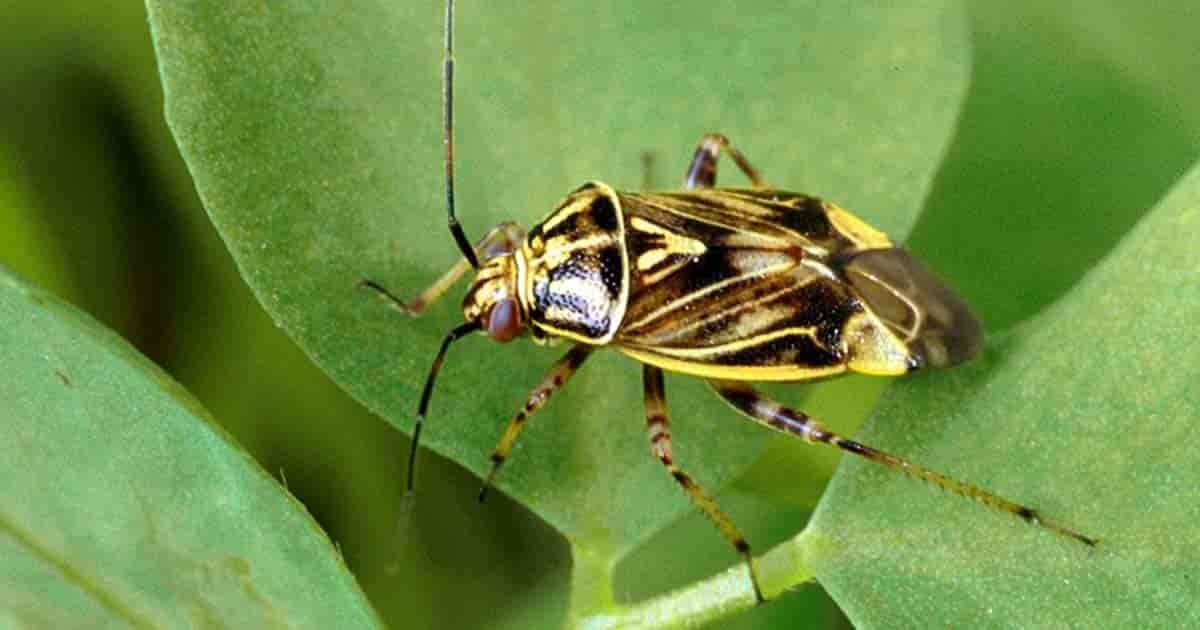 Tarnished Bug – image via USGA
Tarnished Bug – image via USGA
The tarnished plant bug focuses mostly on ornamental flowers. The four-lined plant bug has a voracious appetite and feeds on approximately 250 species of herbaceous plants.
The two types of bugs cause slightly differing damages.
Larvae of the four-lined plant bugs suck the cell juices out of leaves and leave behind discolored areas approximately 1/16th of an inch across.
These damaged areas often become translucent or black, then the dead tissue falls and small holes are left behind.
Adult bugs eat leaves’ upper surfaces, usually consuming the top leaves of a plant first.
When the tarnished plant bug attacks a plant, it may suffer loss of buds or foliage distortion.
This usually happens when adult bugs that have overwintered consume plant buds early in the springtime.
This sort of damage causes plants to lose height and become bushy.
If the bugs attack following the start of shoot elongation, the tips of the shoots may turn black and wither away.
Alternately, the shoot may continue to grow in a stunted and distorted manner. Stems that have been attacked often break at the injury site. [source]
Thrips
Thrips are very tiny, slim insects that grow no greater than 3/16th of an inch long.
Adults vary in color, ranging from pale shades of yellow to solid black. They have four fringed, narrow wings but do not fly well.
When they take up residence on a plant, they simply spread slowly over it rather than moving from one plant to another.
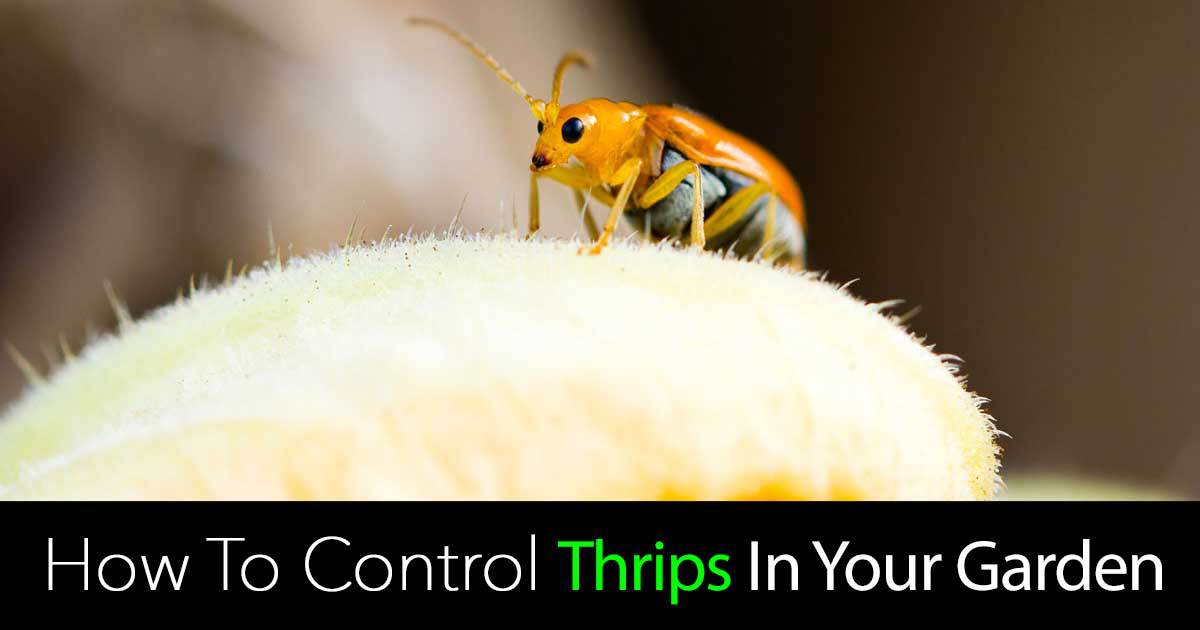 Thrips nymphs are white or light yellow, wingless and even smaller than the adults.
Thrips nymphs are white or light yellow, wingless and even smaller than the adults.
None of the qualities of thrips are visible to the naked eye, though. You’ll need a magnifying glass to see all of these identifying factors.
All forms of thrips pose a real threat to buds, flowers, fruit, leaves and even twigs.
When they eat, they punch holes in the host plant’s epidermal layer with a large mandible (tooth) and consume the cell sap as it flows from the puncture.
After thrips have fed, a plant’s foliage will look dull, dusty or silvery.
Some types of thrips behave like leaf miners by burrowing into leaves to feed.
Leaves that have been injured appear scarred and discolored.
When they attack flowers, the blooms become brown-streaked and wither suddenly. When fruit is attacked, its skin becomes pitted.
Although it is hard to see individual thrips, it is not hard to know that your plants are infested.
The insects tend to mass together in groups of hundreds of individuals.
When they inhabit a plant, they leave dark fecal deposits on the undersides of its leaves. These deposits are slick and hard like varnish.
There are many different species of thrips, and they may behave differently.
Some are actually beneficial in that they prey on other tiny insects such as mites and destructive thrips. Some eat fungal spores that pose a threat to plants.
On the other hand, some carry diseases from one plant to another, and some even bite human beings. [source]
More on Getting Rid on Thrips on Plants
Tomato Hornworms
 Hornworms are a big problem. There are two types that are especially problematic in the United States.
Hornworms are a big problem. There are two types that are especially problematic in the United States.
- Manduca quinquemaculata (tomato hornworm) has a black horn and a total of 16 diagonal stripes (8 per side).
- Manduca sexta (tobacco hornworm) has a curved red horn and a total of 7 diagonal stripes per side.
Both types are bright green with white, striped markings and a large horn at the tail end.
Both types cause a great deal of damage to members of the hemlock family:
- Potatoes
- Peppers
- Eggplant
- Tomatoes
- Tobacco
Hornworms have voracious appetites and consume whole leaves, stems, and chunks of fruit.
Their presence is obvious because the caterpillars are so large and flashy and their damage is so visible.
Additionally, they leave fairly large, dark droppings on plant leaves and on the ground surrounding the infested plant.
More on Getting Rid Of Hornworms
Garden Webworm
The garden webworm (achyra rantailis) feeds on a wide variety of vegetables, especially beans of all sorts.
As adults, these pests are nondescript moths. They are beige or tan in color with scattered gray markings and a wingspread of approximately 3/4 of an inch.
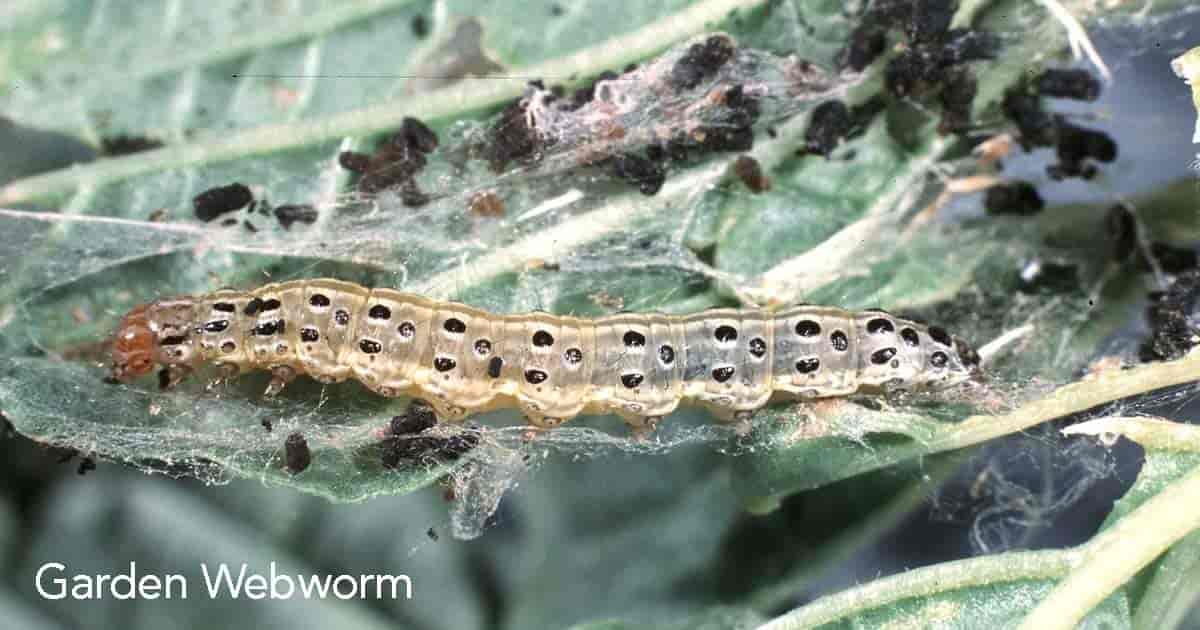 Garden webworm By Alton N. Sparks, Jr., University of Georgia / © Bugwood.org, CC BY 3.0 us, Link
Garden webworm By Alton N. Sparks, Jr., University of Georgia / © Bugwood.org, CC BY 3.0 us, Link
The caterpillars (larvae) spin webs and pull leaves in to consume them. They “skeletonize” leaves by feeding on the undersides and leaving only the veins.
The caterpillars are about an inch long and may range in color from light yellow to dark green with a lighter horizontal stripe on the back and a trio of dark spots in each body segment along the sides. These spots form a triangular shape. [source]
More on Garden and Lawn Webworms
Fall Webworm Control: How To Get Rid Of (Hyphantria cunea)
Sod Webworm: How To Identify And Get Rid Of Sod Webworms
Related: The abundant, sociable tent caterpillar. Considered pests because of their ability to quickly strip a small tree or host plant of its leaves.
Tent Caterpillar: Identifying And Getting Rid Of Tent Caterpillars [DETAILS]
Wireworms
Wireworms eat many different types of field crops and common vegetables.
True to their name, these pests are long, thin and wire-like. They range in size from a quarter inch to an inch.
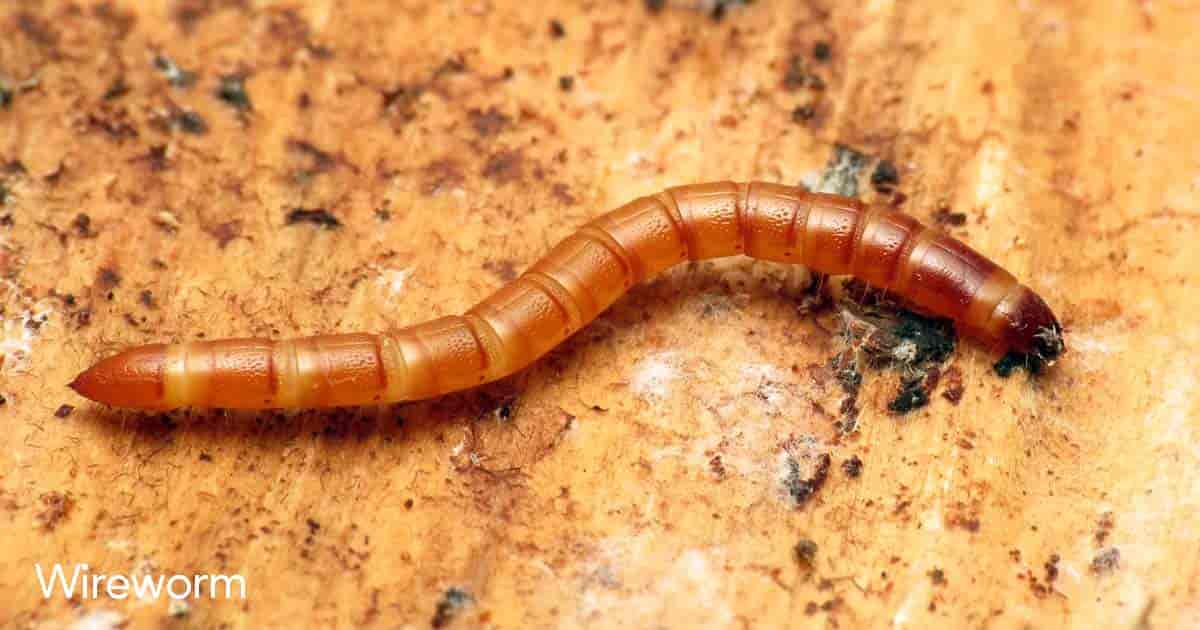 Wireworm – image via Flickr |Katja Schulz
Wireworm – image via Flickr |Katja Schulz
Wireworms grow up to be common click beetles. These brown, segmented bad beetles range in size from a quarter inch to an inch long.
The body of a click bug is long and tapered with a “hinge” in the middle. When it feels threatened, it clicks the hinge and springs away.
Plants attacked by wireworms may not be able to germinate because the pests consume the interior of seeds and leave only an empty hull.
When a field is infested, plants may start poorly from the outset. Alternately, they may get off to a good start only to fail and die soon after.
This is because the wireworms not only eat the insides of seeds set out to germinate, they also remain in the ground and eat the roots of plants that do manage to germinate.
Soil that has not been tended, or amended and fields in which crops are not rotated for long periods of time are subject to the worst infestation.
Learn about Wireworms: What Are They and How To Control Them
Squash Bug
The squash bug or Anasa tristis is a threat to all cucubit vine crops. These include:
- Watermelon
- Cantaloupe
- Cucumber
- Pumpkin
- Squash
Both the adult insects and the nymphs suck the juice right out of plants.
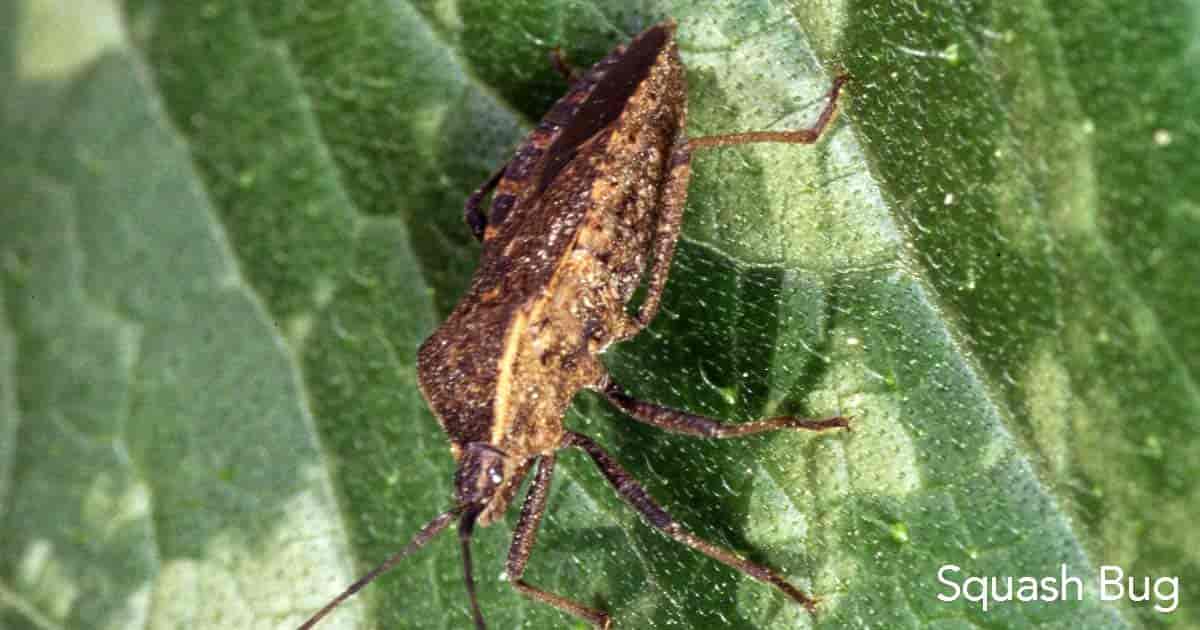 Squash bug. (Anasa nistis) – image via USDA
Squash bug. (Anasa nistis) – image via USDA
When adults overwinter, they can cause a great deal of damage when they emerge from their slumber hungry in the early spring.
They begin preying on young plant shoots as soon as they spring from the soil. This early and voracious feeding can severely stress or kill young plants.
More mature plants are able to tolerate a few squash bugs. Both adults and nymphs prefer to eat leaves, but if leaves are not available, they will eat stems and fruits.
Adult squash bugs are usually seen alone. They are flat-backed, brown or gray and about half an inch long. They have orange stripes on their bellies.
They can fly but usually simply stroll about on plants.
Nymphs are much small and swift and tend to congregate on leaves’ undersides. The nymphs are gray with very long black legs.
Earwigs
Earwigs are often thought of as pests, and they do cause a little damage to tender young seedlings, but they are actually quite valuable as beneficial predators.
These small, nondescript brown bugs are very helpful when it comes to keeping aphids under control.
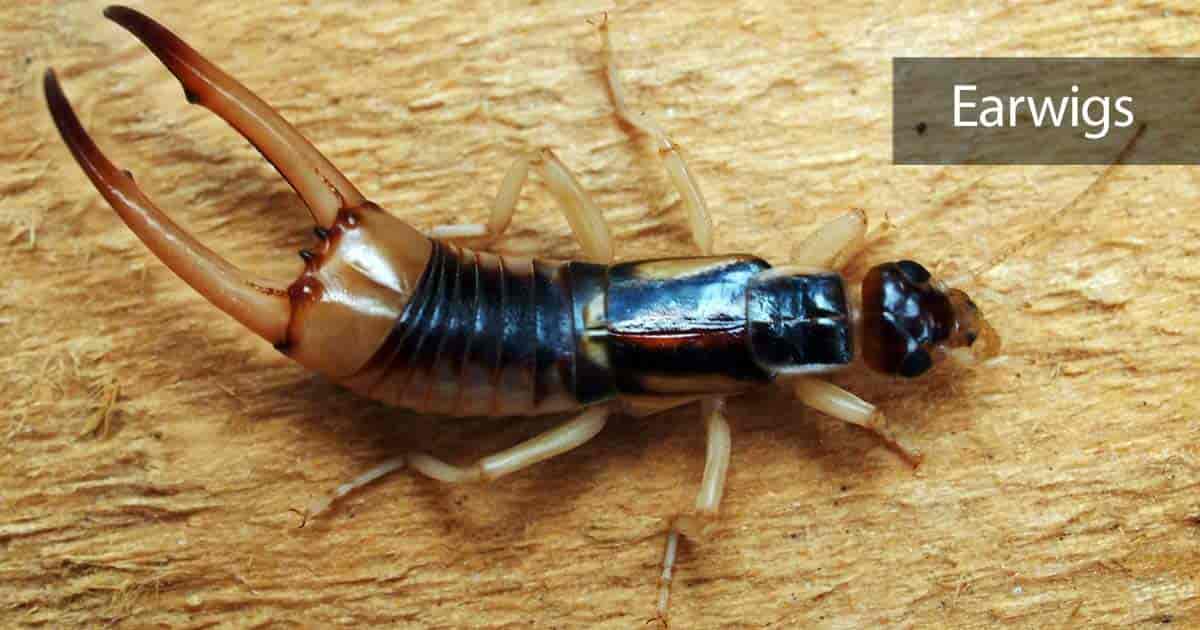 This is especially true of the type of aphids that attack fruit trees and flowering trees.
This is especially true of the type of aphids that attack fruit trees and flowering trees.
Earwigs are about 3/4 of an inch long. They have short forewings and pincers at the tail end.
If you find that you have earwigs in your garden, you are really better off keeping them around than trying to do away with them.
More on Earwigs – Getting Rid of Pincher Bugs
Good vs. Bad Bug Knowledge Is Power
It is important to understand that just seeing one or two insect pests doesn’t necessarily mean you have a terrible problem.
A healthy garden that has a good balance of beneficial vs. detrimental insects can usually tolerate a few pests.
Learning to recognize all of the denizens of your garden is your first line of defense against “bad bugs”.
This video from the University of Georgia College of Agriculture and Environmental Sciences provides clear images and information to help you differentiate between good and bad bugs.
Managing Garden Insects Begins with a Question: Friend or Foe?
Being able to recognize bad garden bugs and keeping a vigilant eye out for them is the first step in an effective program of Integrated Pest Management (IPM).
Keen observation will go far toward keeping your garden healthy and relatively pest-free.


 Armyworm known as the “Beet Armyworm”
Armyworm known as the “Beet Armyworm”
 Blister Beetle image via Flickr
Blister Beetle image via Flickr
 Image Via Flickr – CC 3.0
Image Via Flickr – CC 3.0





 See page for author [Public domain], via Wikimedia Commons
See page for author [Public domain], via Wikimedia Commons







 Melittia Cucurbite: Squash Vine Borer – Moth – image via: Insects Unlocked | James Marchment
Melittia Cucurbite: Squash Vine Borer – Moth – image via: Insects Unlocked | James Marchment
 Harlequin Bug Murgantia histrionica, a common pest of brassicas, raised by USDA – image via USGS
Harlequin Bug Murgantia histrionica, a common pest of brassicas, raised by USDA – image via USGS Tarnished Bug – image via USGA
Tarnished Bug – image via USGA

 Garden webworm By Alton N. Sparks, Jr., University of Georgia / © Bugwood.org, CC BY 3.0 us, Link
Garden webworm By Alton N. Sparks, Jr., University of Georgia / © Bugwood.org, CC BY 3.0 us, Link Wireworm – image via Flickr |Katja Schulz
Wireworm – image via Flickr |Katja Schulz Squash bug. (Anasa nistis) – image via USDA
Squash bug. (Anasa nistis) – image via USDA